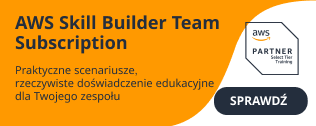Dodatkowe informacje
| Wymagania wstępne | We recommend that attendees of this course have:
|
|---|---|
| Poziom trudności | |
| Czas trwania | 4 dni |
| Certyfikat | The participants will obtain certificates signed by AWS (course completion). This course also helps you prepare for the AWS Certified SysOps Administrator - Associate SOA-C02 exam and this way gain the AWS Certified SysOps Administrator - Associate title – associate level. AWS certification exams are offered at Pearson Vue test centers worldwide https://home.pearsonvue.com/Clients/AWS.aspx |
| Prowadzący | AWS Authorized Instructor (AAI) |
Pozostałe szkolenia AWS | AWS Jam and AWS Jam Bundle
CENA SZKOLENIA OD 6000 PLN NETTO
W celu zaproponowania terminu dla tego szkolenia prosimy o kontakt z Działem Handlowym
Najbliższe szkolenia AWS
-
2026-01-05 | 1 dzień | Kraków / Virtual Classroom
AWS Technical Essentials
szkolenie dostępne w wersji stacjonarnej we wskazanej lokalizacji lub w trybie zdalnym, w zależności od preferencji uczestnika: HYBRID -
2026-01-05 | 1 dzień | Warszawa / Virtual Classroom
AWS Technical Essentials
szkolenie dostępne w wersji stacjonarnej we wskazanej lokalizacji lub w trybie zdalnym, w zależności od preferencji uczestnika: HYBRID -
2026-01-08 | 1 dzień | Kraków / Virtual Classroom
AWS Technical Essentials
szkolenie dostępne w wersji stacjonarnej we wskazanej lokalizacji lub w trybie zdalnym, w zależności od preferencji uczestnika: HYBRID -
2026-01-08 | 1 dzień | Warszawa / Virtual Classroom
AWS Technical Essentials
szkolenie dostępne w wersji stacjonarnej we wskazanej lokalizacji lub w trybie zdalnym, w zależności od preferencji uczestnika: HYBRID -
2026-01-09 | 1 dzień | Kraków / Virtual Classroom
AWS Cloud Practitioner Essentials
szkolenie dostępne w wersji stacjonarnej we wskazanej lokalizacji lub w trybie zdalnym, w zależności od preferencji uczestnika: HYBRID -
2026-01-09 | 1 dzień | Warszawa / Virtual Classroom
AWS Cloud Practitioner Essentials
szkolenie dostępne w wersji stacjonarnej we wskazanej lokalizacji lub w trybie zdalnym, w zależności od preferencji uczestnika: HYBRID -
2026-01-12 | 1 dzień | Kraków / Wirtualna sala
AWS Technical Essentials
szkolenie dostępne w wersji stacjonarnej we wskazanej lokalizacji lub w trybie zdalnym, w zależności od preferencji uczestnika: HYBRID -
2026-01-13 | 3 dni | Kraków / Wirtualna sala
Architecting on AWS
szkolenie dostępne w wersji stacjonarnej we wskazanej lokalizacji lub w trybie zdalnym, w zależności od preferencji uczestnika: HYBRID -
2026-01-13 | 3 dni | Warszawa / Wirtualna sala
Architecting on AWS
szkolenie dostępne w wersji stacjonarnej we wskazanej lokalizacji lub w trybie zdalnym, w zależności od preferencji uczestnika: HYBRID -
2026-01-14 | 3 dni | Kraków / Wirtualna sala
Developing on AWS
szkolenie dostępne w wersji stacjonarnej we wskazanej lokalizacji lub w trybie zdalnym, w zależności od preferencji uczestnika: HYBRID


